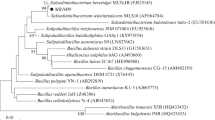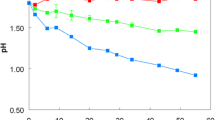Summary
Factors affecting chromate reduction by cultures of Enterobacter cloacae HO1 were investigated. The reduction was sensitive to oxygen stress and E. cloacae strain HO1 could reduce chromate only under anaerobic conditions. Rates of reduction of chromate were proportional to cell number. The optimal pH was between 7.0 and 7.8, and the optimal temperature was 30°–37°C. High rates of reduction were observed at levels of 1–2 mM potassium chromate, but concentrations above 5 mM were lethal to growing cells and prevented the reduction. Acetate, ethanol, malate, succinate and glycerol were effective electron donors for chromate reduction. Glucose, citrate, pyruvate and lactate supported anaerobic growth, but only limited amounts of reduction were observed with these organic compounds. Chromate reduction by strain HO1 was inhibited by molybdate, vanadate, tellurate and manganese oxide at concentrations where the cell viability was not significantly affected. Metabolic poisons including carbonylcyanide-m-chlorophenyl hydrazone, sodium cyanide, formaldehyde and zinc sulphate also inhibited chromate reduction.
Similar content being viewed by others
References
Cervantes C, Ohtake H (1988) Plasmid-determined resistance to chromate in Pseudomonas aeruginosa. FEMS Lett 56:173–176
Gupta GS, Prasad G, Singh VN (1988) Removal of chrome dye from carpet effluents using coal. Environ Technol Lett 9:153–161
Horitsu H, Futo S, Miyaza Y, Ogai S, Kawai K (1987) Enzymatic reduction of hexavalent chromium by hexavalent chromium toterant Pseudomonas ambigua G-1. Agric Biol Chem 51:2417–2420
Lebedeva EV, Lyalikova NN (1979) Reduction of crocoite by Pseudomonas chromatophilia sp. nov. Mikrobiologiya 48:517–522
Ohtake H, Cervantes C, Silver S (1987) Decreased chromate uptake in Pseudomonas fluorescens carrying a chromate resistance plasmid. J Bacteriol 169:3853–3856
Petrilli FL, Flora SD (1977) Toxicity and mutagenicity of hexavalent chromium on Salmonella typhimurium. Appl Environ Microbiol 33:805–809
Romanenko VI, Korenkov VN (1977) A pure culture of bacteria utilizing chromate and bichromates as hydrogen acceptors in growth under anaerobic conditions. Mikrobiologiya 46:414–417
Srivastava HCP, Mathur RP, Mehrotra I (1986) Removal of chromium from industrial effluents by adsorption on sawdust. Environ Technol Lett 7:55–63
Urone PF (1955) Stability of colorimetric reagent for chromium, S-diphenylcarbazides, in various solvents. Anal Chem 27:1354–1355
Venitt S, Levy LS (1974) Mutagenicity of chromates in bacteria and its relevance to chromate carcinogenesis. Nature 250:493–495
Author information
Authors and Affiliations
Rights and permissions
About this article
Cite this article
Komori, K., Wang, Pc., Toda, K. et al. Factors affecting chromate reduction in Enterobacter cloacae strain HO1. Appl Microbiol Biotechnol 31, 567–570 (1989). https://doi.org/10.1007/BF00270796
Received:
Accepted:
Issue Date:
DOI: https://doi.org/10.1007/BF00270796




